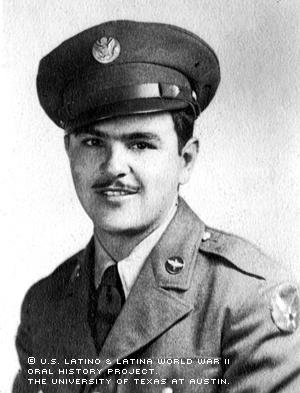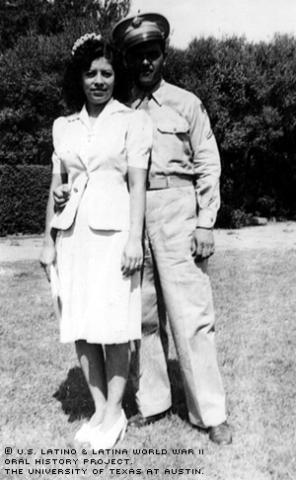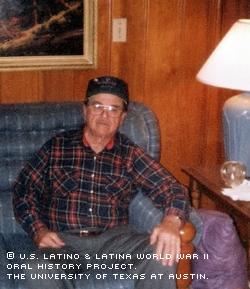


By Stephanie Scalco
Our Lady of Sorrows Catholic Church, where Domingo Treviño attended, staged bazaars on a regular basis. At one of them, when he was a young man, Treviño was talking to a couple of pretty girls, and two guys approached him, looking for trouble. Although he said he never had problems with people and got along with everyone well, this time he took the boys up on their offer to go outside and fight. One boy had a gun, and gave it to his friend to hold while he and Treviño started fighting. Treviño wrapped both arms around him and struggled, and they both fell to the ground. At this point, the boy with the gun pushed it into Treviño’s back and pulled the trigger.
The gun didn't fire.
The fight ended, and some of Treviño’s friends and a priest came over. They took the gun away and made all three boys shake hands. A friend of Treviño’s took the gun home that night and tested it. Every shot fired.
"I guess the good Lord looked after me," said Treviño, able now to laugh at the incident.
He said it seems God has always looked after him, in particular when he was a hurricane hunter in the South Pacific, as a member of the 55th Reconnaissance Weather Squadron.
Treviño was born on August 4, 1921, to Zacarias and Anastasia Treviño in Hempstead, Texas, 50 miles northwest of Houston. Zacarias worked for a man named Will Bennett. A well-known person, Will served as a deputy sheriff in the late 1800s, according to Waller County records. Will was so pleased with Zacarias’ work that he gave him 30 acres of land, Treviño recalled.
In 1925, when Treviño was only 3 1/2 years old, his mother died. She was buried in a corner on their property. In 1928, the family moved to Houston when Treviño’s father traded his land for two lots there.
Treviño started elementary school at Elliot Elementary late, at 7 years old, since his father would take the kids out of school part of the year to pick cotton. They would travel all around the Houston area, and outside the city to Chapel Hill and Brookshire. Treviño learned at a young age what it meant to work hard.
"When I was 10 years old, they used to crank up an old tractor and they would put me on top of that and I would drive it on the fields," he said.
When he was able to be in school, Treviño was a good student, making straight A's even though he was gone much of the time. Occasionally, he and his family felt prejudice towards them because of their Mexican heritage. When they learned about the battle of the Alamo at school, the other kids gave him a hard time.
"The [Anglo] boys used to really hate us," he said. "But it didn't bother me so much because I was bigger than the rest of them."
Treviño’s school days ended when he was in 6th grade because his father decided to move the family back to Mexico. It was cheap, 15 to 20 cents per person, to cross the bridge between Texas and Mexico. Their work frequently took them away from their home in Monterrey, Nuevo Leon. While away, they would stay with families who would tell them stories of ghosts haunting their houses. When Treviño would get scared, his father would always remind him of reality.
"My daddy said, 'Don't you ever worry about a ghost. The dead will never bother you; be careful of the living,'" Treviño recalled.
When Treviño was about 14 or 15 years old, his father remarried. He and one of his brothers, Mike, decided to return to Houston. It was a hard trip, and the brothers were extremely poor.
"We nearly starved on the way back, but we made it," he said.
He found a job working in the kitchen of a motel. For four to five months, Treviño made $7 weekly for seven days of work from 6 a.m. to 6 p.m. After a short stint as a night guard and a conversation with his friend, Frank Delacruz, he landed a job at the company Frank worked for.
"He said, 'Mingo, why don't you come over where I'm working? They're hiring.' So I went to work at Nagel's Coat Hanger Company."
This was in 1937. Treviño would continue to work for Nagel's most of his life, both before and after his participation in World War II.
Shortly after the incident with the gun at the church bazaar, Treviño met a pretty young girl named Isabel Flores. The two became a couple and were married on August 23, 1941, at Guadalupe Church in Houston. Four months later, on a Sunday morning, a bomb was dropped on Pearl Harbor in Hawaii.
By this time, Treviño had been promoted to foreman of one of Nagel's plants. But with the onset of America's involvement in the war, people began leaving work to fight. The company didn’t want to lose him, but eventually he signed up for the Army. In 1942, he received his papers to report for duty.
On Jan. 5, 1943, Treviño and about six or seven other men boarded a train to San Antonio. It was a rainy, cold day and he wore a maroon sweater Isabel gave him. The men had to go from building to building, filling out paperwork, getting military-issued clothing and completing other business.
"From building one to the next, three times that day, I stood outside, I came back inside, got dried up completely. By the time we got dried up, we had to go outside again," he recalled.
Two days later, the new recruits went on an 18-mile hike through the mud. It wasn't bad for Treviño since he was used to being on his feet. When he got back, however, he started coughing. Four days later, he was in the infirmary. He wanted to go to Ohio with the rest of the men, but the general didn't think it would be beneficial to his health.
"He told me, 'Where you're gonna go, where this group here is going, the snow is up to your moustache,'" Treviño said.
He was diagnosed with pneumonia. When he recovered, he was asked to fill out a questionnaire for classification. The classification happened to be the same sort of work he’d done at Nagel's, and a week later, he went to Wichita Falls, Texas.
He briefly faced more racism there when a higher-ranking official told him to separate from the group and go with the other Mexicans. He refused.
"I'm just as American as the rest of them," he said. "I was born here, so I figured I was an American."
No action was taken against him.
After basic training, Treviño was told he would go to airplane mechanic school. He was there for 3 1/2 months. Class was from 11 p.m. to 7 a.m., and the students stood the entire time. There were no desks or chairs.
"It was the hardest time of my life," he said. "But I always came out with real good grades."
Treviño was then sent to gunnery school in Florida. After gunnery school, where he finished second in his class, the military sent him to Salt Lake City, Utah, to the 18th Replacement Wing. He got injured three days after arriving, however, so he was out for six weeks.
"All my buddies left," he said. "I was assigned to Lt. Richard Schultz's crew assistant fight engineer and was shipped with the crew to Casper, Wyo., for bomb training."
He and his crew were assigned to Oklahoma City for long-range order photoreconnaissance. They took pictures of the practice bomb drops, and then returned.
Treviño took what were called mosaic pictures, which were pieced together after development into a larger picture that the crew would then study.
Before the crew was finished with this assignment, their orders changed. A storm had blown up in the Pacific and caused a lot of damage. They were assigned to long-range weather reconnaissance to protect against further damage to planes flying out. They flew from Oklahoma City to New Orleans to Galveston and back to Oklahoma City, constantly checking the weather.
Treviño was the assistant engineer. His job was to check the gas on the plane and switch the plane from auxiliary to regular power after it took off.
After Oklahoma City, the crew was assigned to Guam. After getting a new plane in Savannah, Ga, Treviño and his crew went to Guam and became the first members of the 55th Weather Reconnaissance Squadron.
"We were the first, last and only hurricane hunters in the Pacific. We were called the 'Hurricane hunters of the Pacific,'" he said.
Treviño and his crew "flew weather" all over the Pacific, flying out of places like Okinawa and Iwo Jima. In Guam, the crew flew every fourth day, observing the weather in their area. Treviño would volunteer to help with translating in Guam, as many of the people had Spanish names and he was able to communicate with them. One place he volunteered was a leprosy camp, collecting and delivering food.
"They wouldn't let us in, but we would leave all the food," he recalled.
The crew kept themselves busy when they weren't flying. Many would go on the beach to find shells in order to make necklaces for their wives. They were also always on the hunt for soft drinks.
"We were always starving for soda waters, but we didn't have any," he remembered.
During one flight, the crew proved themselves worthy of the Distinguished Flying Cross.
"We went through one (storm) and we didn't expect us to come out," he said.
They had to go from 200 to 2,000 feet above the water in seconds. Drenched in sweat, the pilot and co-pilot controlled the aircraft; the plane was so badly damaged after that trip that it couldn't fly for more than a week.
After those missions, Japan surrendered and Sergeant Treviño was discharged from the Army Air Corps after flying 37 combat missions as assistant light engineer and lower ball target gunner.
Treviño went back to Houston to be with his wife and daughter and began working again for Nagel's. He’s a decorated veteran, the recipient of several awards, including the Distinguished Flying Cross, which is rewarded for heroism and extraordinary achievement in aerial flight. He was the only Latino from Texas who received this award for tracking a typhoon in winds of 90 to 100 miles per hour, 200 to 2,000 feet above the water.
"We were very fortunate to be able to come back," he said.
Treviño attributes his success to hard work.
"Being poor, it gave me a motivation to do something," he said. "When my brother and I were coming back from Mexico -- and we were starving and everything -- I told my brother, 'You know what? The heck with this. I ain't gonna be hungry. I'm gonna work. I'm gonna get myself out of this hole,' which I did."
Mr. Treviño was interviewed in Houston, Texas, on March 30, 2000, by Paul Rodriguez Zepeda.

